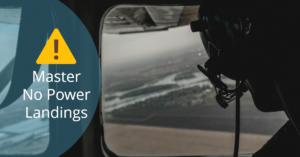 We practice no-power landings with our students all the time – not because it’s fun but because it’s necessary. If you lose your engine mid-flight, it’s critical to know how to get back to the ground safely.
We practice no-power landings with our students all the time – not because it’s fun but because it’s necessary. If you lose your engine mid-flight, it’s critical to know how to get back to the ground safely.
Our certified flight instructors put together this cheat-sheet so you know what actions to take if you’re ever in this situation (although truly, it is rare).
Don’t panic.
Remaining calm and in-control increases your ability to troubleshoot and correct the problem. Knowing you’re prepared for this kind of situation should increase your confidence and eliminate the need to panic – so don’t get mad the next time your flight instructor asks you to practice a no-power landing!
Undo what you just did.
To be honest, many mechanical issues are caused by operator error. Did you accidentally turn off your magneto switches? Did you mistake a mixture knob for a heater knob? If you made a mistake like that, you’ll probably know right away. Correct the error and you may be able to restart the engine.
Look down.
Continue to fly the aircraft, but look for a suitable landing area. A prepared pilot always has an emergency landing spot in mind! Look down (not too far into the horizon) because the perfect landing spot may be in gliding range right below you.
While a runway is preferable, you’re rarely far from a big, flat field or pasture in the Butler area. In some situations, you may be able to land on a road if you can identify that there are no vehicles, signs, or power lines (although that’s almost impossible in areas like Western PA). ATC can help you identify the best landing location – every second counts, so make your decision quickly.
Point your plane to the landing site, and establish best-glide airspeed.
Consult your emergency landing checklist.
Now that you’ve identified a safe landing space, look at your Engine Failure In Flight checklist. It will tell you how to troubleshoot, but also how to prepare for landing.
Prepare for landing.
Ensure that you and your passengers have your seatbelts on and are prepared for landing. Prop the doors open as they may become stuck if you have a hard landing. Again, keep calm. It may take as long as 5 minutes to land from cruising altitude.
Land with confidence.
Try to make it a normal landing. That’s why we practice no-power landings. In practice or in a real emergency, control your glide path using airspeed, slips and flaps. Aim far enough into the field to avoid unseen trees, power lines, and fences. Exit the plane with your passengers quickly in case of fire.
We know that practicing emergency landings can be difficult and stressful, but the more you practice, the more successful you will be at landing in a real emergency situation. Practicing in safe conditions with a Certified Flight Instructor by your side increases your chances of walking away with minimal injuries or damage to your plane.
